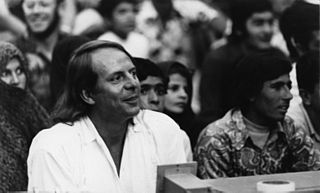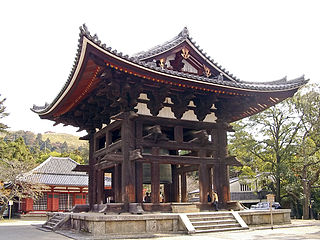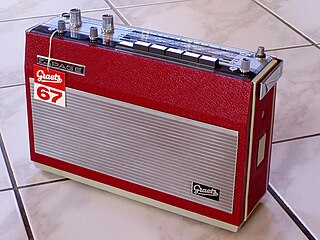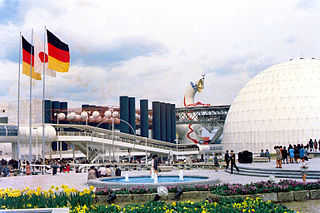Related Research Articles

Process music is music that arises from a process. It may make that process audible to the listener, or the process may be concealed.
David C. Johnson was an American composer, flautist, and performer of live electronic music.

Mantra is a composition by the German composer Karlheinz Stockhausen. It was composed in 1970 and premiered in autumn of the same year at the Donaueschingen Festival. The work is scored for two ring-modulated pianos; each player is also equipped with a chromatic set of crotales and a wood block, and one player is equipped with a short-wave radio producing morse code or a magnetic tape recording of morse code. In his catalogue of works, the composer designated it as work number 32.

Aus den sieben Tagen is a collection of 15 text compositions by Karlheinz Stockhausen, composed in May 1968, in reaction to a personal crisis, and characterized as "Intuitive music"—music produced primarily from the intuition rather than the intellect of the performer(s). It is Work Number 26 in the composer's catalog of works.

Mikrophonie is the title given by Karlheinz Stockhausen to two of his compositions, written in 1964 and 1965, in which "normally inaudible vibrations ... are made audible by an active process of sound detection ; the microphone is used actively as a musical instrument, in contrast to its former passive function of reproducing sounds as faithfully as possible".

Hymnen is an electronic and concrete work, with optional live performers, by Karlheinz Stockhausen, composed in 1966–67, and elaborated in 1969. In the composer's catalog of works, it is No. 22.

Telemusik is an electronic composition by Karlheinz Stockhausen, and is number 20 in his catalog of works.

Kurzwellen, for six players with shortwave radio receivers and live electronics, is a composition by Karlheinz Stockhausen, written in 1968. It is Number 25 in the catalog of the composer's works.

Spiral, for a soloist with a shortwave receiver, is a composition by Karlheinz Stockhausen, written in 1968. It is Number 27 in the catalogue of the composer's works.

Mixtur, for orchestra, 4 sine-wave generators, and 4 ring modulators, is an orchestral composition by the German composer Karlheinz Stockhausen, written in 1964, and is Nr. 16 in his catalogue of works. It exists in three versions: the original version for full orchestra, a reduced scoring made in 1967, and a re-notated version of the reduced scoring, made in 2003 and titled Mixtur 2003, Nr. 162⁄3.

Refrain for three players is a chamber music composition by Karlheinz Stockhausen, and is number 11 in his catalog of works.

Fresco is an orchestral composition written in 1969 by the German composer Karlheinz Stockhausen as foyer music for an evening-long retrospective programme of his music presented simultaneously in three auditoriums of the Beethovenhalle in Bonn. It is Nr. 29 in his catalogue of works, and a performance takes about five hours.

Pole (Poles), for two performers with shortwave radio receivers and a sound projectionist, is a composition by Karlheinz Stockhausen, written in 1970. It is Number 30 in the catalogue of the composer's works.

Expo, for three performers with shortwave radio receivers and a sound projectionist, is a composition by Karlheinz Stockhausen, written in 1969–70. It is Number 31 in the catalogue of the composer's works.
Solo for a melody instrument with feedback is a work for a soloist with live electronics composed in 1965–66 by Karlheinz Stockhausen. It is Nr. 19 in his catalogue of works. Performance duration can vary from 10½ to 19 minutes.
Drei Lieder, for alto voice and chamber orchestra, is a song cycle by Karlheinz Stockhausen, written while he was still a conservatory student in 1950. In the composer's catalogue of works, it bears the number 1/10.

Für kommende Zeiten is a collection of seventeen text compositions by Karlheinz Stockhausen, composed between August 1968 and July 1970. It is a successor to the similar collection titled Aus den sieben Tagen, written in 1968. These compositions are characterized as "Intuitive music"—music produced primarily from the intuition rather than the intellect of the performer(s). It is work number 33 in Stockhausen's catalog of works, and the collection is dedicated to the composer's son Markus.

Litanei 97 is a choral composition by Karlheinz Stockhausen, written in 1997. Although the words are taken from the text-composition cycle Aus den sieben Tagen and the conductor sings and plays elements from the Michael formula used in the composer's Licht cycle of operas, it is an independent work assigned the number 74 in Stockhausen's catalogue of works. It lasts about twenty minutes in performance.

Ensemble is a group-composition project devised by Karlheinz Stockhausen for the 1967 Darmstädter Ferienkurse. Twelve composers and twelve instrumentalists participated, and the resulting performance lasted four hours. It is not assigned a work number in Stockhausen's catalogue of works.

Musik für ein Haus is a group-composition project devised by Karlheinz Stockhausen for the 1968 Darmstädter Ferienkurse. Fourteen composers and twelve instrumentalists participated, with the resulting performance lasting four hours. It was not regarded by Stockhausen as a composition belonging solely to himself, and therefore was not assigned a number in his catalog of works.
References
- ↑ Kohl 1981, pp. 192–193.
- 1 2 Kohl 2010, p. 137.
- ↑ Gehlhaar 1998, p. 53.
- ↑ Stockhausen 1971, pp. 102–103.
- 1 2 Gehlhaar 1998, p. 55.
- ↑ Gehlhaar 1998, p. 62.
- ↑ Cott 1973, p. 33.
- ↑ Stockhausen 1971, p. 103.
- ↑ Stockhausen 1973, pp. 1, 11, 21.
- ↑ Stockhausen 1971, p. 106.
- ↑ "Karlheinz Stockhausen - Prozession". NoBusiness Records. Retrieved March 17, 2023.
Cited sources
- Cott, Jonathan. 1973. Stockhausen: Conversations with the Composer. New York: Simon and Schuster. ISBN 0-671-21495-0.
- Gehlhaar, Rolf. 1998. "Leap of Faith: A Personal Biography of Karlheinz Stockhausen's Prozession." Perspectives of New Music 36, no. 2 (Summer): 53–62. (online version)
- Kohl, Jerome. 1981. Serial and Non-Serial Techniques in the Music of Karlheinz Stockhausen from 1962–1968. Ph. D. diss. Seattle: University of Washington.
- Kohl, Jerome. 2010. "A Child of the Radio Age". In Cut & Splice: Transmission, edited by Daniela Cascella and Lucia Farinati, 135–139. London: Sound and Music. ISBN 978-1-907378-03-4.
- Stockhausen, Karlheinz. 1971. "Prozession für einen Solisten (1968)". In his Texte zur Musik 3, edited by Dieter Schnebel, 102–107. DuMont Dokumente. Cologne: Verlag M. DuMont Schauberg. ISBN 3-7701-0493-5.
- Stockhausen, Karlheinz. 1973. Nr 27 Spiral für einen Solisten. (score) UE 14957. Vienna: Universal Edition.